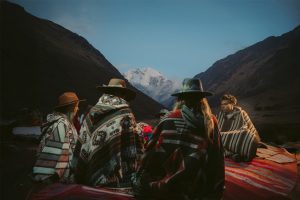Cusco is visited annually by more than 3 million tourists drawn to the beauty of its archeological sites. The architectural richness of the capital of Tawantinsuyu is just one example of the powerful culture that Cusqueños have been able to develop in their region. It will surprise any visitor to find out that not only is Cusco full of archeological sites and natural wonders, but it also has lots of local music. For example, you can see young people using public spaces to play ancestral melodies, enjoy parades of dancers with traditional music in the Plaza de Armas, or take advantage of live music performances in various local bars.
With this post, Salkantay Trekking wants to inaugurate a new tourism path online: “Cusco: Musical Universe”. From time to time, we’ll present a specially chosen Cusquenian song that you can easily find online to discover more deeply the mysteries that await you in Cusco or to remember your time here after you’ve left.
For this first post, we want to take the time to reflect, through Cusquenian music, on our motivation, our paths, and the way we choose to face life. Let’s get started!
1. Viajero que Nace / Manu Vera Tudela
“Viajero que nace” (Born Traveler) speaks of the destiny of a traveler, the importance of following your heart, and the need to move in order to heal. This song, with relaxing and dream-like melodies, will motivate you to decide once and for all to create a new adventure for yourself. Manu Vera Tudela is a musician from Lima who launched a search for himself in Cusco. His musical style is extremely diverse: it ranges from experimental rock to a fusion of traditional Peruvian music (Andean, Amazonian, and Afro-Peruvian). He’s released 4 albums you can hear on Spotify.
2. Hospital Regional / Marisol Cavero
In Cusco, Andean music is the most popular, diverse, and innovative genre. Huayno, traditional Andean music with a modern touch, inspires countless new artists every year and has millions of followers. Marisol Cavero is one of the most well-known huayno singers in southern Peru. She was born in the district of Ccapi, province of Paruro, region of Cusco. En Hospital Regional, a song from one of her first albums “La Voz Angelical”, Marisol Cavero reflects about health and the importance of being grateful to those who help us make progress for the future. The song tells the story of a woman remembering terrible moments she’s had in the hospital. This song, apart from bringing out a desire to dance, can help you value your health and the luck that goes with you every day.
3. Como Seguir / Coco Saenz

Coco Saenz is an artist who’s drawn a lot of attention with only 2 singles released on Spotify. His colorful voice, the freshness of his electric guitar, and the depth of his lyrics make him one of the most hopeful Cusquenian artists to rise up in the international music industry. His first single, “Como Seguir” (How to Go On), released on Spotify in 2017, is a catchy indie pop song about self-discovery and healing from a local, sacred plant known as San Pedro or Wachuma. If you feel something is off with you, take advantage of your time in Cusco to connect with these sacred plants and get rid of that unsettling feeling you’ve carried with you for so long.
4. Hasta el Final / William Luna

William Luna is also a renowned Andean music artist. In contrast to Marisol Cavero, who uses mostly the harp and electric percussion, William Luna prefers the guitar, charango (a small stringed instrument of the Andes), and Andean flute to express feelings. In “Hasta el Final” (Until the End), there’s a deep and poetic reflection of love and the fact that little by little, life passes us by never to return. Death is something that everyone experiences sooner or later, and since that destiny is inevitable, we should be motivated to live an abundant, intense, and happy life.
5. Dime, Destino / Conjunto Condemayta de Acomayo

The Conjunto Condemayta de Acomayo is a living legend of traditional huayno. Since their formation in 1970, they’ve captured the hearts of all generations of Cusquenians. For their progress, cultural importance, and artistic quality, they’ve been awarded by the Peruvian Ministry of Culture with the title, “Cultural Heritage of the Nation”. Under the direction of Saturnino Pulla Jiménez and with the melodious voice of María Tintaya Rayo, the Calandria del Sur, the Conjunto Condemayta de Acomayo has composed wonderful songs in Quechua. In “Dime, Destino” (Tell Me, Destiny), they sing of the overwhelming feeling of uncertainty that invades us all from time to time. No matter where we come from, we will always face that sensation of not knowing what to do or where to go. However, the sound of the harmonica and the trill of the mandolin work like healing charms that drive us to move forward without fear of what’s to come.













Leave A Reply